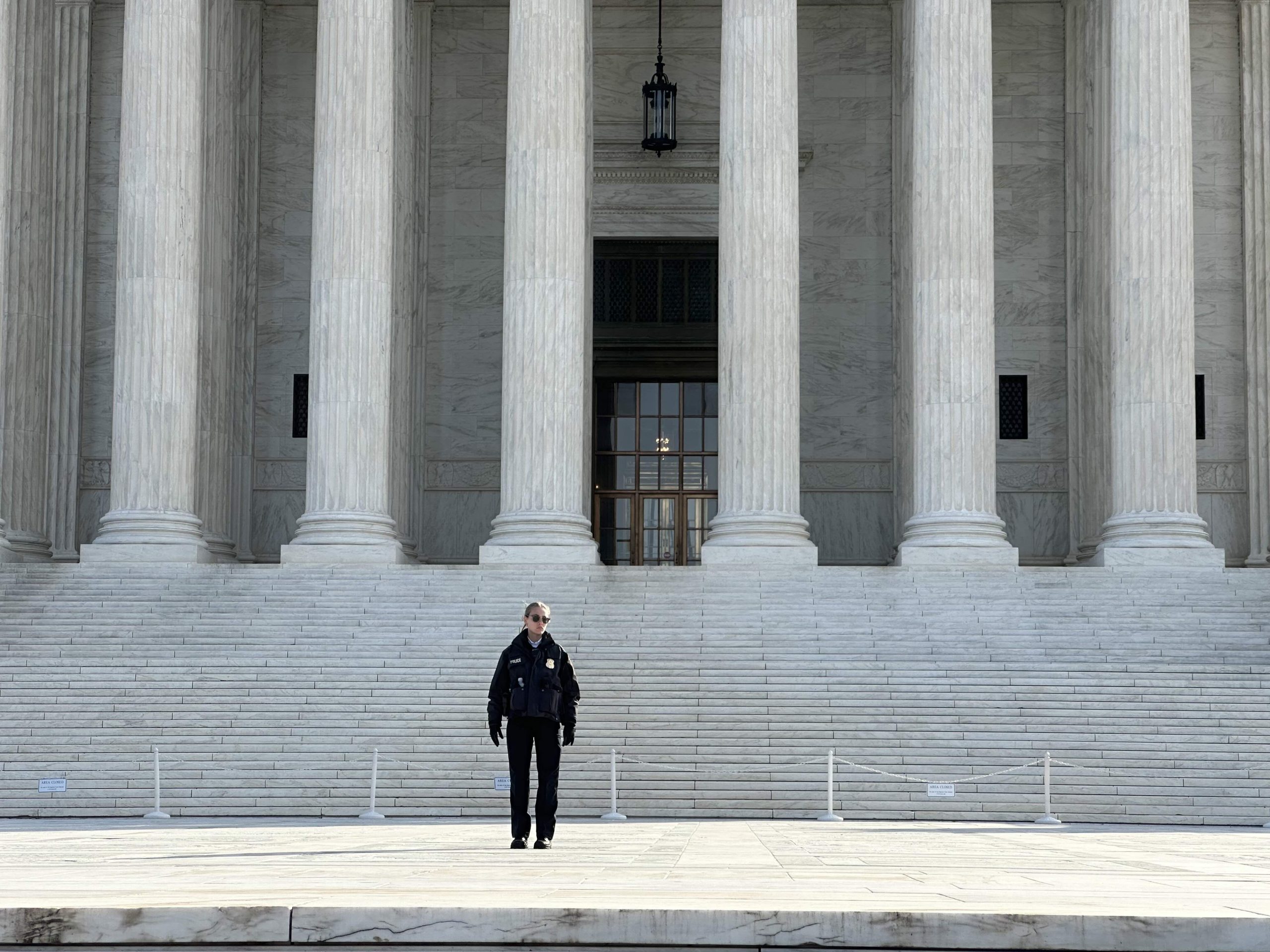Bump-stock ban comes before Supreme Court
CASE PREVIEW
on Feb 27, 2024
at 6:53 pm
The justices will end their February argument session with two cases, Garland v. Cargill and Coinbase v. Suski. (Katie Barlow)
The Supreme Court has already heard oral argument in one major gun-rights case this term, and on Wednesday the court will hear another. In November, the justices heard United States v. Rahimi, a challenge to the constitutionality of a federal law that makes it a crime for someone who is the subject of a domestic-violence restraining order to have a gun. Wednesday’s case involves the interpretation of federal law rather than the Second Amendment. The question before the court in Garland v. Cargill is whether a rifle equipped with a “bump stock” – an attachment that transforms a semiautomatic rifle into a weapon that can discharge hundreds of rounds per minute simply with one movement by the shooter – is a “machinegun,” which is generally prohibited under federal law.
The case began as a challenge to a regulation issued by the Trump administration in the wake of the 2017 mass shooting at a music festival in Las Vegas. The gunman there used semi-automatic rifles equipped with bump-stock devices to kill 60 people and injure 500 more. In 2018, the Bureau of Alcohol, Tobacco, Firearms, and Explosives issued a rule concluding that bump stocks are machine guns. In reaching that conclusion, ATF reversed course from its earlier position that only certain types of bump stocks are machine guns. The 2018 rule directed anyone who owned or possessed a bump stock to destroy them or drop them at a nearby ATF office to avoid facing criminal penalties.
Michael Cargill, the owner of a gun store in Austin, surrendered several bump stocks he had in his store after ATF published its rule. He then went to court, seeking to have the rule invalidated.
The full U.S. Court of Appeals for the 5th Circuit ruled in Cargill’s case that the definition of “machinegun” clearly does not apply to bump stocks. A machine gun, the court of appeals explained, is a gun that shoots multiple bullets “automatically” and “by a single function of the trigger,” or any accessory that allows a gun to do so. But even if the definition were not clear, the 5th Circuit continued, bump stocks should be excluded from the definition of “machinegun” under the rule of lenity, a doctrine that instructs courts to apply ambiguous criminal laws in the way that is most favorable to defendants.
In a different challenge, the U.S. Court of Appeals for the 6th Circuit reached the same conclusion. In its view, the rule is ambiguous. And because federal firearms laws do not “clearly and unambiguously prohibit bump stocks,” the 6th Circuit concluded, the rule of lenity applies and it was “bound to construe the statute in” the defendant’s favor.
In a third challenge to the rule, the U.S. Court of Appeals for the District of Columbia Circuit upheld the regulation. It concluded that “under the best interpretation of the statute, a bump stock is a self-regulating mechanism that allows the shooter to shoot more than one shot through a single pull of the trigger” and is therefore a “machinegun.”
The Biden administration came to the Supreme Court last year, asking the justices to review the rulings by the 5th and 6th Circuits striking down the rule; the bump-stock owners who lost in the D.C. Circuit also sought review of that ruling. In November, the justices agreed to review the 5th Circuit’s ruling in Cargill’s case.
In its brief in the Supreme Court, the Biden administration argues that a semiautomatic rifle equipped with a bump stock falls squarely within the definition of “machinegun”: It shoots “automatically more than one shot, without manual reloading, by a single function of the trigger.”
First, U.S. Solicitor General Elizabeth Prelogar explains, with a bump stock, a semiautomatic rifle can file multiple shots (indeed, “hundreds of rounds per minute”) with “a single function of the trigger” – that is, with a single pull of the trigger by the shooter or with a single push of the rifle forward to press the trigger against his trigger finger.
Second, Prelogar continues, the rifle operates “automatically.” “Once the shooter pulls the trigger and initiates a bump-firing cycle,” she writes, he doesn’t need to push or pull again to fire more shots.
More broadly, Prelogar adds, the Supreme Court “has long recognized that courts should avoid reading statutes” in a way that would easily allow their circumvention. Here, Prelogar emphasizes, Congress passed a law to bar new machine guns because they allow the shooter to fire rapidly without having to repeatedly pull the trigger – precisely the same thing that bump stocks do. “Holding that rifles equipped with bump stocks are nonetheless lawful would exalt artifice above reality,” she concludes.
Finally, Prelogar pushes back against any suggestion that the rule of lenity also weighs in Cargill’s favor. The rule of lenity, she observes, should only come into play if the statute “remains grievously ambiguous” after all other tools of statutory interpretation have been applied. But the definition of “machinegun” is not ambiguous, she writes.
In his brief on the merits, Cargill also focuses on the statutory definition of “machinegun.” He contends that it does not cover bump stocks, for two reasons.
First, he argues, although a bump stock can speed up firing, semiautomatic rifles equipped with bump stocks do not fire more than one shot “by single function of the trigger.” Instead, the shooter must release and re-engage the trigger for each shot.
Second, Cargill continues, bump stocks do not cause semiautomatic rifles to fire more than one shot “by a single function of the trigger” “automatically” because the shooter has to apply continuous pressure with both hands: He must simultaneously push the front of the rifle forward with his non-trigger hand and at the same time engage the trigger with his trigger hand and keep his finger there so that it re-engages the trigger when the rifle moves forward after recoiling, while also pushing the rifle back with his trigger hand.
Cargill rejects the Biden administration’s suggestion that a semiautomatic rifle equipped with a bump stock falls within the kind of weapon that Congress intended to cover within the definition of “machinegun.” It doesn’t matter how many shots a semiautomatic rifle equipped with a bump stock can fire, he emphasizes. “What matters under the statute is what the trigger does,” he writes, “and whether a ‘single function of the trigger’ results in the firing of more than one shot.”
If Congress wanted the definition of “machinegun” to hinge on how quickly a weapon can fire or how lethal it is, Cargill notes, it could have done so – but it did not. Whether the current definition “should be updated to encompass weapons that achieve the results of machineguns ‘through different technological means’ is a decision for Congress to make, not agencies or courts,” Cargill concludes.
Like the Biden administration, Cargill believes that the definition of “machinegun” is clear and unambiguous (even if reaching the opposite conclusion). This means that the Supreme Court’s 1984 decision in Chevron v. Natural Resources Defense Council, holding that courts should defer to an agency’s interpretation of an ambiguous statute as long as that interpretation is reasonable, does not apply – both because the definition is clear and because Chevron does not apply to laws that define criminal offenses. (In another case, the Supreme Court is currently considering whether to overrule the Chevron doctrine.)
But even if the statute were ambiguous, Cargill concludes, the court should interpret the law to favor Cargill under the rule of lenity and because “a ruling that endorses ATF’s interpretative rule will raise serious constitutional questions.” Specifically, Cargill contends, by labeling the bump-stock rule as an “interpretative” rule, ATF is indicating that rifles equipped with bump stocks have always been machine guns, which would “retroactively make felons out of the hundreds of thousands of Americans who possessed or transferred bump stocks in reliance on ATF’s representations of their legality.”
This article was originally published at Howe on the Court.






